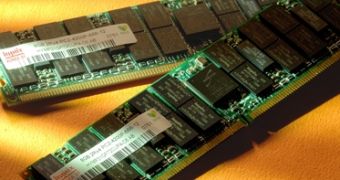MetaRAM has been keeping its business away from prying eyes since it was founded, back in 2006. Led by the ex-Advanced Micro Devices CTO, Fred Weber, the company was dealing with RAM, but nobody would be able to tell what it was cooking in its laboratories.
Things have become crystal clear as MetRAM has finally pulled the veil off its ultimate technology: a welcome refresh to the old but still powerful SDRAM Dimm. More to the point, the MetaRAM modules are an evolutionary step to the old standard, and allows it to hold 4GB or 8GB of memory on a single card, with no further modifications to the motherboard or DIMM slots.
The MetaRAM modules are perceived by the computer just like normal DDR2 memory, so it would be the ideal replacement especially for server memory, where extra memory comes with a premium value. The advent of the new technology will not only bring systems with astounding memory configurations, but will also decrease the price in the custom hardware area. For instance, one of the company's OEM partners will unveil a server system carrying 500 GB (you read it correctly, that's five hundred gigabytes) of memory for a sub-$50,000 price.
While 500 GB of memory might seem as it's more than even a high-performance server can carry, the advent of virtualization and enterprise databases will require extremely large amounts of memory on a single server machine. According to MetaRAM estimations, more than 80 percent of enterprise server databases are under 500GB in size, which could perfectly fit into servers' main memory, in order to fetch data at dazzling speeds.
The company has used a 3D chip layout in order to increase the SDRAM chips' density onto a single DIMM. Moreover, each DIMM is comprised of two or four DIMMs worth of memory, joined together and coordinated by a pair of custom chips. They are acting like a buffer between the system's main memory controller and the on-DIMM DRAMs, and routes reads and writes to the proper DRAM, while keeping a low profile itself.
"We had to make our chip look like a DRAM to the memory controller, and like a memory controller to the DRAMs," said Suresh Rajan, the MetaRAM co-founder whom I talked to about the company's technology. This memory traffic routing messes with the DDR2 DRAM timings quite a bit, so the MetaRAM chipset's dynamic command scheduling circuitry ends up doing a kind of "out-of-order execution" with the flow of reads and writes so that the DIMM can operate at a full 667MHz without any glitches.
One of the first memory builders to use the new technology is Hinyx Semiconductor, that has just announced its HYMP31GP72CUP4-C6, a 2-Rank 8GB PC2-4200 RDIMM. The modules are built exclusively on MetaRAM's MetaSDRAM technology, that allowed Hinyx to get its new 8GB server memory modules.

 14 DAY TRIAL //
14 DAY TRIAL //